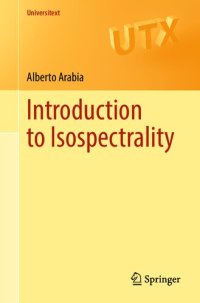
Ebook: Introduction to Isospectrality
Author: Alberto Arabia
- Genre: Mathematics // Geometry and Topology
- Tags: Spectral Geometry Isospectrality Flat Manifold Laplacian Buser Spaces GWW-Domains
- Series: Universitext
- Year: 2022
- Publisher: Springer Nature Switzerland
- City: Cham, Switzerland
- Edition: 1
- Language: English
- pdf
"Can one hear the shape of a drum?" This striking question, made famous by Mark Kac, conceals a precise mathematical problem, whose study led to sophisticated mathematics. This textbook presents the theory underlying the problem, for the first time in a form accessible to students.
Specifically, this book provides a detailed presentation of Sunada's method and the construction of non-isometric yet isospectral drum membranes, as first discovered by Gordon–Webb–Wolpert. The book begins with an introductory chapter on Spectral Geometry, emphasizing isospectrality and providing a panoramic view (without proofs) of the Sunada–Bérard–Buser strategy. The rest of the book consists of three chapters. Chapter 2 gives an elementary treatment of flat surfaces and describes Buser's combinatorial method to construct a flat surface with a given group of isometries (a Buser surface). Chapter 3 proves the main isospectrality theorems and describes the transplantation technique on Buser surfaces. Chapter 4 builds Gordon–Webb–Wolpert domains from Buser surfaces and establishes their isospectrality.
Richly illustrated and supported by four substantial appendices, this book is suitable for lecture courses to students having completed introductory graduate courses in algebra, analysis, differential geometry and topology. It also offers researchers an elegant, self-contained reference on the topic of isospectrality.
Specifically, this book provides a detailed presentation of Sunada's method and the construction of non-isometric yet isospectral drum membranes, as first discovered by Gordon–Webb–Wolpert. The book begins with an introductory chapter on Spectral Geometry, emphasizing isospectrality and providing a panoramic view (without proofs) of the Sunada–Bérard–Buser strategy. The rest of the book consists of three chapters. Chapter 2 gives an elementary treatment of flat surfaces and describes Buser's combinatorial method to construct a flat surface with a given group of isometries (a Buser surface). Chapter 3 proves the main isospectrality theorems and describes the transplantation technique on Buser surfaces. Chapter 4 builds Gordon–Webb–Wolpert domains from Buser surfaces and establishes their isospectrality.
Richly illustrated and supported by four substantial appendices, this book is suitable for lecture courses to students having completed introductory graduate courses in algebra, analysis, differential geometry and topology. It also offers researchers an elegant, self-contained reference on the topic of isospectrality.
Download the book Introduction to Isospectrality for free or read online
Continue reading on any device:

Last viewed books
Related books
{related-news}
Comments (0)